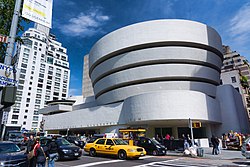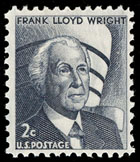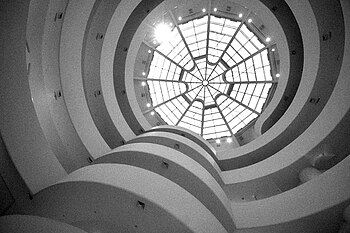Solomon R. Guggenheim Museum
 Viewed from Fifth Avenue | |
| Established | 1937 |
|---|---|
| Location | Upper East Side, Manhattan, New York, U.S. |
| Type | Art museum |
| Director | Richard Armstrong |
| Public transit access | 86th Street (IRT Lexington Avenue Line) |
| Website | www |
| Location | 1071 Fifth Ave., New York, New York, USA |
| Area | less than one acre |
| Built | 1959 |
| Architect | Wright, Frank Lloyd; Cohen, George |
| Architectural style | Modern Movement |
| NRHP reference No. | 05000443[1] |
| Added to NRHP | May 19, 2005 |
The Solomon R. Guggenheim Museum (often referred to as "The Guggenheim") is a well-known art musespiral along the outer edges of the building until it reaches the ground level. The building underwent extensive expansion and renovations from 1992 to 1993 (when an adjoining tower was built) and from 2005 to 2008. The museum's collection has grown organically, over eight decades, and is founded upon several important private collections, beginning with Solomon R. Guggenheim's original collection. The collection is shared with the museum's sister museums in Bilbao, Spain, and elsewhere.
History
Early years
Solomon Guggenheim, guided by his art adviser, German painter Hilla Rebay, began to collect works by nonobjective artists in 1929. Guggenheim first began to show his collection in his apartment, and as the collection grew, he established the Solomon R. Guggenheim Foundation in 1937. The foundation's goal was the "promotion and encouragement and education in art and the enlightenment of the public." It was endowed to operate one or more museums; Solomon Guggenheim was elected its first President and Rebay its Director.

In 1939, the Guggenheim Foundation's first museum, "The Museum of Non-Objective Painting", opened in rented quarters at 24 East 54th Street in New York City and showcased art by early modernists such as Rudolf Bauer, Rebay, Wassily Kandinsky, Paul Klee and Piet Mondrian. During the life of Guggenheim's first museum, Guggenheim continued to add to his collection, acquiring paintings by Marc Chagall, Robert Delaunay, Fernand Léger, Amedeo Modigliani and Pablo Picasso. The collection quickly outgrew its original space, and so in 1943, Rebay and Guggenheim wrote a letter to Frank Lloyd Wright asking him to design a permanent structure for the collection. Wright accepted the opportunity to experiment with his organic style in an urban setting. It took Wright 15 years, 700 sketches, and six sets of working drawings to create the museum. From 1943 to early 1944, Wright produced four different sketches for the initial design. While one of the plans (scheme C) had a hexagonal shape and level floors for the galleries, all the others had circular schemes and used a ramp continuing around the building. He had experimented with the ramp design on the house he completed for his son in 1952, the David & Gladys Wright House in Arizona. At the same time as Wright was developing the design, Rebay was searching for sites for the museum. She selected the museum's site at the corner of 89th Street and Fifth Avenue, overlooking Central Park.

In 1953, the foundation's collecting criteria expanded under its new director, James Johnson Sweeney. Sweeney rejected Rebay's dismissal of "objective" painting and sculpture, and he soon acquired Constantin Brâncuși's Adam and Eve (1921), followed by works of other modernist sculptors, including Jean Arp, Alexander Calder, Alberto Giacometti and David Smith.[2] Sweeney reached beyond the 20th century to acquire Paul Cézanne's Man with Crossed Arms (c. 1899).[2] In that year, the foundation also received a gift of 28 important works from the Estate of Katherine S. Dreier, a founder of America's first collection to be called a modern art museum, the Société Anonyme. Dreier had been a colleague of Rebay's. The works included Little French Girl (1914–18) by Brâncuși, an untitled still life (1916) by Juan Gris, a bronze sculpture (1919) by Alexander Archipenko and three collages (1919–21) by German Hanoverian Dadaist Kurt Schwitters. It also included works by Calder, Marcel Duchamp, El Lissitzky and Mondrian.[3] Among others, Sweeney also acquired the works of Alberto Giacometti, David Hayes, Willem de Kooning and Jackson Pollock.[4]
Sweeney oversaw the last half dozen years of the construction of the museum building, during which time he had an antagonistic relationship with Frank Lloyd Wright, especially regarding the building's lighting issues.[5][6] The distinctive cylindrical building, turned out to be Wright's last major work, as the architect died six months before its opening.[7] From the street, the building looks like a white ribbon curled into a cylindrical stack, wider at the top than the bottom, displaying nearly all curved surfaces. Its appearance is in sharp contrast to the typically rectangular Manhattan buildings that surround it, a fact relished by Wright, who claimed that his museum would make the nearby Metropolitan Museum of Art "look like a Protestant barn."[7] Internally, the viewing gallery forms a helical spiral ramp climbing gently from ground level to the skylight at the top.[7]
The building

On October 21, 1959, ten years after the death of Solomon Guggenheim and six months after the death of Frank Lloyd Wright, the Museum first opened its doors to large crowds.[8][9] The building instantly polarized architecture critics,[7][10] though today it is widely praised.[11] Some of the criticism focused on the idea that the building overshadows the artworks displayed inside,[12] and that it is difficult to properly hang paintings in the shallow, windowless, concave exhibition niches that surround the central spiral. Prior to its opening, twenty-one artists signed a letter protesting the display of their work in such a space.[7]
Thomas M. Messer succeeded Sweeney as director of the museum (but not the foundation) in 1961 and stayed for 27 years, the longest tenure of any of the city's major arts institutions' directors.[13] When Messer took over, the museum's ability to present art at all was still in doubt due to the challenges presented by continuous spiral ramp gallery that is both tilted and has non-vertical curved walls.[14] It is difficult to properly hang paintings in the shallow, windowless exhibition niches that surround the central spiral: canvasses must be mounted raised from the wall's surface. Paintings hung slanted back would appear "as on the artist's easel". There is limited space within the niches for sculpture.[7]

Almost immediately, in 1962, Messer took a risk putting on a large exhibition that combined the Guggenheim's paintings with sculptures on loan from the Hirshhorn collection.[14] Three dimensional sculpture, in particular, raised "the problem of installing such a show in a museum bearing so close a resemblance to the circular geography of hell", where any vertical object appears tilted in a "drunken lurch" because the slope of the floor and the curvature of the walls could combine to produce vexing optical illusions.[15] It turned out that the combination could work well in the Guggenheim's space, but, Messer recalled that at the time, "I was scared. I half felt that this would be my last exhibition."[14] Messer had the foresight to prepare by staging a smaller sculpture exhibition the previous year, in which he discovered how to compensate for the space's weird geometry by constructing special plinths at a particular angle, so the pieces were not at a true vertical yet appeared to be so.[15] In the earlier sculpture show, this trick proved impossible for one piece, an Alexander Calder mobile whose wire inevitably hung at a true plumb vertical, "suggesting hallucination" in the disorienting context of the tilted floor.[15]
The next year, Messer acquired a private collection from art dealer Justin K. Thannhauser for the museum's permanent collection.[16] These 73 works include Impressionist, Post-Impressionist and French modern masterpieces, including important works by Paul Gauguin, Édouard Manet, Camille Pissarro, Vincent van Gogh and 32 works by Pablo Picasso.[3][17]
In 1992, the building was supplemented by an adjoining rectangular tower, taller than the original spiral, designed by the architectural firm of Gwathmey Siegel & Associates Architects.[18] By that point, the building had become iconic enough that this augmentation of Wright's original design was itself controversial.
Later years
Works and Process is a series of performances at the Guggenheim begun in 1984.[19] The first season consisted of Philip Glass with Christopher Keene on Akhnaten and Steve Reich and Michael Tilson Thomas on The Desert Music. In October 2005, Lisa Dennison, a longtime Guggenheim curator, was appointed director of the Solomon R. Guggenheim Museum in New York. Dennison resigned in July 2007, to work at the auction house Sotheby's.[20]
In 2005, Thomas Krens, director of the Solomon R. Guggenheim Foundation, won a dispute with billionaire philanthropist and board member Peter Lewis. A significant contributor to the Foundation, Lewis resigned over the direction and leadership of the Foundation.[21] In February 2008, Krens stepped down as the Director of the Foundation, but he remains an advisor to the Guggenheim's international expansion projects. Richard Armstrong, formerly director of Pittsburgh's Carnegie Museum of Art, was appointed as the museum's fifth director.[22] Curators at the museum include Nancy Spector.
Exterior restoration

Between September 2005, and July 2008, the Guggenheim Museum underwent a significant exterior restoration.
In the first phase of this project, a team of restoration architects, structural engineers, and architectural conservators worked together to create a comprehensive assessment of the building's current condition that determined the structure to be fundamentally sound. This initial condition assessment included:
- the removal of 11 coats of paint from the original surface, revealing hundreds of cracks caused over the years, primarily from seasonal temperature fluctuations[23]
- detailed monitoring of the movement of selected cracks over 17 months
- impact-echo technology, in which sound waves are sent into the concrete and the rebound is measured in order to locate voids within the walls
- extensive laser surveys of the exterior and interior surfaces, believed to be the largest laser model ever compiled
- core drilling to gather samples of the original concrete and other construction materials
- testing of potential repair materials.[24]
Much of the interior of the building was restored during the 1992 renovation and addition by Gwathmey Siegel and Associates Architects. The 2005–2008 restoration primarily addressed the exterior of the original building and the infrastructure. This included the skylights, windows, doors, concrete and gunite facades and exterior sidewalk, as well as the climate-control. The goal was to preserve as much significant historical fabric of the museum as possible, while accomplishing necessary repairs and attaining a suitable environment for the building's continuing use as a museum.[25] On September 22, 2008, friends and supporters of the Guggenheim gathered in New York to mark the completion of the three-year renovation of the Frank Lloyd Wright-designed Museum. New York City Mayor Michael R. Bloomberg officiated at the celebration that culminated, just after sunset, with the premiere of artist Jenny Holzer's tribute For the Guggenheim,[26] a work commissioned in honor of Peter B. Lewis, who was a major benefactor in the Museum restoration project. Other supporters of the $29 million restoration included the Board of Trustees of the Solomon R. Guggenheim Foundation, and the Department of Cultural Affairs of the City of New York. Additional support was provided by the State of New York and MAPEI Corporation.[27] The museum was registered as a National Historic Landmark on October 6, 2008.[28]
Significance in popular culture

The building has become a cultural icon and can be seen widely throughout popular culture. It is featured in Matthew Barney's The Cremaster Cycle, Someone to watch over me, Bye Bye Birdie, Men in Black, When in Rome, Downtown 81, Ugly Betty and prominently in The International, where a major shootout occurs in the museum. (In fact, a life-size replica of the museum was built for this scene.[29]). The film Mr. Popper's Penguins has a sequence where the penguins cause a disturbance entering the museum, wander to the top of the gallery structure and slide down the entire spiral structure to the ground floor.
The New Yorker has included the museum multiple times on its cover and cartoons.[citation needed] The Marvel Comics Guide to New York City (2007) by Peter Sanderson points out that the Guggenheim museum played a part in Daredevil (Marvel Comics), vol. 1, #61 (1970), What If (comics) (featuring Conan the Barbarian), vol. 1, #13 (1979), and Thor (Marvel Comics) #447-48 (1992).[citation needed]
See also
| External videos | |
|---|---|
 | |
- Guggenheim family
- List of museums and cultural institutions in New York City
- Museum Mile
- V. C. Morris Gift Shop, site of ramp prototype
- List of all museums founded by the Guggenheim Foundation
- The Art of the Motorcycle
- Ling Po
References
- ^ "National Register Information System". National Register of Historic Places. National Park Service. March 13, 2009.
- ^ a b Calnek, Anthony, et al. The Guggenheim Collection, pp. 39–40, New York: The Solomon R. Guggenheim Foundation, 2006. ISBN 978-0892073498
- ^ a b "Guggenheim Museum New York", Encyclopedia of Art, visual-arts-cork.com, accessed April 18, 2012
- ^ The Global Guggenheim, The Solomon R. Guggenheim Museum Publications, accessed March 8, 2012
- ^ "James Johnson Sweeney Administrative papers", Solomon R. Guggenheim Museum Publications, accessed March 8, 2012
- ^ Glueck, Grace. "James Johnson Sweeney Dies; Art Critic and Museum Head". The New York Times. April 15, 1986.
- ^ a b c d e f "Art: Last Monument". Time. November 2, 1959.
- ^ Spector, p. 16
- ^ "Guggenheim Foundation History", The Solomon R. Guggenheim Foundation, 2010
- ^ "Controversial Museum Opens in New York", The News and Courier, October 22, 1959, p. 9-A, accessed March 1, 2012
- ^ "The Wright Stuff". USA Today (Weekend). November 6, 1998[dead link]
- ^ Winter, Damon. "Solomon R. Guggenheim Museum", The New York Times, October 21, 2009, accessed March 7, 2012
- ^ Lisa Kumar (2011). "Thomas M. Messer". The Writers Directory. Detroit: St. James Press. ISBN 9781558628137.
- ^ a b c Russell, John. "Director of Guggenheim Retiring After 27 Years", The New York Times, November 5, 1987, accessed April 14, 2012
- ^ a b c Canaday, John. "Museum Director Solves Problem; Guggenheim Official Faces Troubles of Architecture", The New York Times, August 17, 1962
- ^ Decker, Andrew. "Oral History Interview with Thomas M. Messer, 1994 Oct.-1995 Jan.", Archives of American Art, January 25, 1995, accessed March 13, 2012
- ^ "Thannhauser, Justin K.: The Frick Collection", Archives Directory for the History of Collecting in America, accessed March 13, 2012
- ^ Gwathmey Siegel web site: Overview of firm's history, projects, etc.
- ^ Works and Process
- ^ Vogel, Carol. "Director of Guggenheim Resigns to Join Sotheby's". The New York Times. July 31, 2007.
- ^ Vogel, Carol. "Guggenheim Loses Top Donor in Rift on Spending and Vision", January 20, 2005, The New York Times, accessed December 6, 2012
- ^ Vogel, Carol. "Guggenheim Chooses a Curator, Not a Showman". The New York Times. September 23, 2008.
- ^ Haeyoun Park. "Face-lift for an Aging Museum". The New York Times. April 16, 2007. – graphic illustration of cracking.
- ^ Pogrebin, Robin. "The Restorers' Art of the Invisible". The New York Times. September 10, 2007, pp. E1-5.
- ^ Guggenheim Museum web site: click link to podcast about restoration (10 MB, audio only, 8 min 45 sec)
- ^ Villarreal, Ignacio. [url=http://www.artdaily.com/index.asp?int_sec=2&int_new=26285 "Guggenheim Marks Completion of Restoration With First Public Viewing of Work by Artist Jenny Holzer", Artdaily.com, accessed May 8, 2009
- ^ Guggenheim Museum web site: click link to streaming video, broadband only[dead link]
- ^ "National Register of Historic Places; New Listings October 6 – October 10, 2008", NPS.gov, October 17, 2008, accessed May 8, 2009
- ^ Shineberg, Susan. [url=http://www.theage.com.au/news/arts/walltowall-culture/2007/11/09/1194329483873.html?page=fullpage "Wall-to-wall culture"], The Age, November 10, 2007
- ^ "Frank Lloyd Wright, Solomon R. Guggenheim Museum". Smarthistory at Khan Academy. Retrieved January 4, 2013.
External links
- Official website
- Gwathmey Siegel Solomon R. Guggenheim Museum Renovation and Addition project page
- Architectural Review
- Art of the Motorcycle Exhibit
- New York Academy of Sciences Podcast about Imageless Exhibit
- Happy 50th Birthday, Guggenheim – slideshow by Life magazine
- 50 Facts on Guggenheim's 50th – Daily News archives
- The Guggenheim 50th Birthday Party
- Art museums in New York City
- Buildings and structures completed in 1959
- Buildings and structures on the National Register of Historic Places in Manhattan
- Fifth Avenue (Manhattan)
- Frank Lloyd Wright buildings
- Guggenheim family
- Guggenheim Museum
- Modern art museums in the United States
- Modernist architecture in New York
- Museums established in 1937
- Museums in Manhattan
- Museums of American art
- National Historic Landmarks in New York City
- Rotundas




